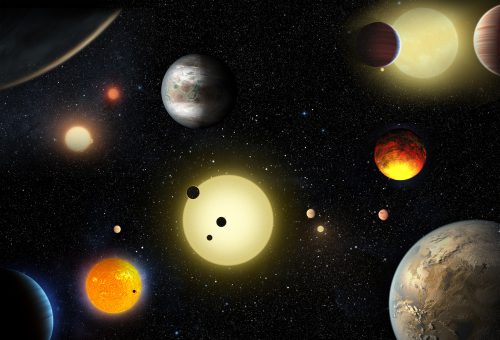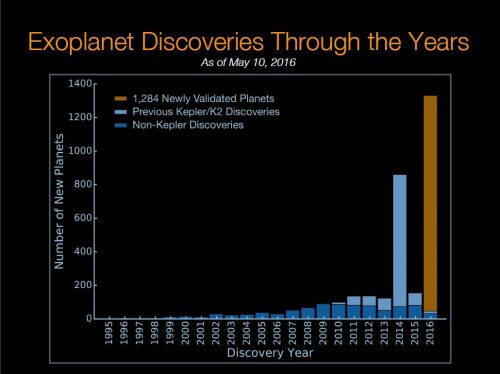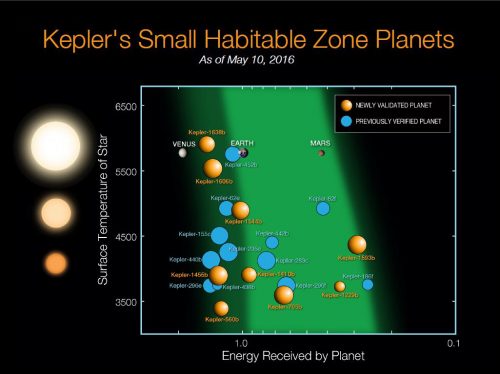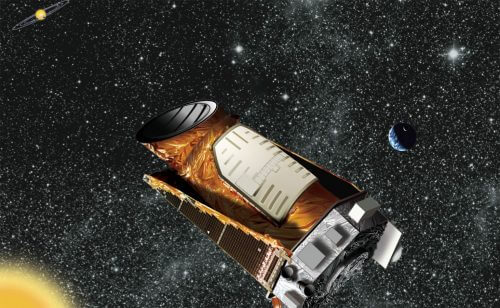In the biggest-ever announcement of extrasolar planets, NASA announced that it has successfully verified the reliability of 1,284 planet discoveries made by the Kepler space telescope. The size of about 100 of them is similar to that of the Earth, and 9 of them were found in the sitting area around the star they orbit, and may thus be suitable for life.

The new announcement of NASA raises the number of known extrasolar planets (or in the foreign term "exo-planets") to 3,200, of which 2,325 were detected by the Kepler space telescope, and the rest were mostly detected by observations from the ground.
"Before the launch of the Kepler space telescope, we did not know whether extrasolar planets were common in the galaxy. Thanks to Kepler and the research community, we now know that there may be more planets than stars," said Paul Hertz, director of the Astrophysics Division at the NASA Administration. "This information will make it possible to determine future missions that are necessary to take us closer than ever to knowing if we are alone in the universe."
The new planets are not "new" in the full sense of the word, but were taken from the large pool of "candidates" for planets, those identified by the Kepler space telescope but not yet verified. Kepler identified during his main mission (between 2009 - 2013) almost 5,000 "candidates".

Until now, the process of verifying the observations of the Kepler space telescope has been quite complicated and proceeded slowly. The reason for this lies in the indirect method in which Kepler identifies planets - the transit method. Since with the existing technology it is impossible to directly observe exoplanets (although a very small number of distant and very large planets have been detected directly), the researchers are assisted by indirect methods, and the method used by Kepler requires verification by additional methods.
The transit method utilizes the passage of a planet around its star, similarly for Monday's passage of the planet Mercury across our Sun. If the plane of the planet's orbit happens to be in the viewing angle of the telescope, it will slightly dim the star's light received by the telescope. If this dimming occurs regularly and continuously, it can be concluded that the cause is a planet orbiting the star. Kepler requires at least 3 such observations to determine that a planet has been observed.
Until now, the transit method required additional observations from the ground, especially a method known as "radial velocity", which measures the effect of the planet on the movement of the star during its orbit around it. Because ground-based observations take longer, the process of confirming Kepler's observations has taken a long time so far.
In the current published catalog, the Kepler mission team used an innovative method that makes it possible to verify the observations with a reliability level of over 99%, without the need for follow-up observations from the ground. The method examines the information produced by Kepler regarding the dimming of the star's light as well as existing information regarding potential alternative explanations that may rule out the observation. Such alternative explanations could be, for example, double systems of stars. By utilizing the existing knowledge of how common such binary systems are and where they are located in the galaxy, it is possible to reach a high probability of 99% or higher.
The researcher who developed the new method, Timothy Morton from Princeton University in New Jersey, explained that there were such methods in the past, but so far they were done in a limited and non-automatic way. The new method he developed is computerized and calculates the probability of each planet in just a few minutes.
"You can think of planet candidates like breadcrumbs," Morton explained. "If you drop big breadcrumbs on the floor, you can pick them up one by one. But, if you spill a whole pack of tiny crumbs, you'll need a broom. This statistical analysis is our broom."

At the press conference where NASA announced the discovery, it was stated that among the new planets, about 100 are estimated to have less than 1.2 Earth masses, so most likely they are rocky, similar to Earth. The "rockiness" of a planet is not enough in the search for the "holy grail" of exoplanets - an Earth-like planet that is in the sitting region around the planet, neither too far nor too close to its parent star, so that it receives enough energy to allow the existence of liquid water on its surface the planet
Of these 100, 9 were identified within the sitting area. Together with the other known planets in this region, their number now stands at 21 planets that may be suitable for sustaining life.
It is important to note that despite this they may still be hostile to life, as additional factors influence this. For example, the planet Venus is, according to some estimates, at the edge of the sitting region of our Sun, but due to its dense atmosphere that is mainly composed of carbon dioxide, an accelerated process of a greenhouse effect took place there, which brings the surface temperatures to over 400 degrees Celsius. Definitely not a place that encourages life.
The Kepler space telescope was launched in 2009 and continued its main mission until 2013, when it suffered a mechanical failure that necessitated the termination of the main mission. The mission managers were able to "save" the telescope and continued with a secondary mission known as K2, which also searches for extrasolar planets, but the planets now announced were taken from the previous observations of the main mission. According to NASA, there are another 1,327 candidates that are most likely to be verified as planets, and another 707 observations that will likely turn out to be erroneous.

The Kepler space telescope is one of the first missions to locate extrasolar planets, in a field of research that has been developing at an astronomical rate in recent years. Besides the ground observations that are increasing year by year, next year will be launched into space TESS space telescope of NASA. TESS will be very similar to Kepler and will also use the transit method, but it will observe the entire sky and closer and brighter stars for a shorter period of time, while Kepler observed a limited and fixed point in the sky for an extended period of 4 years. Another European Space Agency telescope named CHEOPS Will be launched in 2018 and will also use the transit method.
In 2018, the James Webb Space Telescope will also be launched, which will serve as a "successor" to the old Hubble Space Telescope. Webb, which will be the largest telescope ever launched into space, will be able to analyze the chemical composition of the atmospheres of these planets. Such a chemical composition, similar to the Earth's atmosphere which is full of evidence for the existence of life (such as oxygen and methane), may indicate the existence of life on distant planets. NASA scientists are also planning even more advanced missions, ones that will be able to hide the light of the star around which the planets orbit and observe them directly (such as The WFIRS space telescope).

7 תגובות
Eddie,
In your reference to the error, I think you are referring to the high values given to the parameters and not to the formula itself. Regarding the values given to the parameters, both you and I are trying to make an educated guess, since we don't have enough statistics with high enough degrees of freedom to make correct statistics. The problem is that the only planet we really know intimately is KdHA, so we don't know if it is the exception or the rule. By the way, in this case, it is even better if we refer to the Seeger equation, which refers to the discovery of life through observing the gases in the atmospheres of the outer planets.
We have 3 NASA-like planets in the solar system and currently we know for sure that only one of them has life. We do not know for sure that there is no life on the other two or if there was at any time in the past, which are Mars and Venus, although the chances of life on Venus are very slim (there is a theory that talks about the possibility of single-celled existence in the upper atmosphere of Venus).
Regarding Mars, the chances there have increased since the discovery of flowing water on Mars, and in addition, Mars was probably covered with large bodies of water in the past. If we look at the only example we know, life in XNUMX began right when the conditions were created that allowed the creation of life (abiogenesis). This immediacy suggests that life may arise relatively easily and the phenomenon is common once the right conditions are present. If so, this may also have been the case on Mars, and life formed there in the past when it contained large bodies of water.
If we look at the latest data from the studies of extremophiles (life forms that can survive in extreme conditions), we see that life adapts to high temperatures, low temperatures, little water, high radiation, etc. It can be assumed that perhaps some of the life forms in the past of Mars, managed to survive in certain niches on Mars, such as in the depths of the earth or in caves on Mars, etc.
In addition to this, today there is also talk about the possibility of life on the moons of the gas giants. It turns out that there is also liquid water there (even whole oceans), and again if the conditions exist maybe primitive life forms could have developed there as well.
I'm interested in where the statistics you brought about the likelihood of abiogenesis came from?
On the other hand, there is a mystery that still has no answer: all life forms that exist today in the Earth evolved from the same lineage of primordial life, and there are no other competing lineages. The question is why weren't other dynasties of life created at the same time as the current one? Was the current dynasty so successful that it occupied all the available niches and caused the extinction of the others? Did the others become extinct in the great extinctions? Or was there actually only one dynasty created?
We do not currently have enough data to answer these questions.
Avi Cohen,
Regarding the Drake formula - the error in the formula is clear, and focuses on the evaluation of the (F (l) factor. It turns out that the probability of the spontaneous creation of a surviving primary organic cell is a negative decimal power on the order of minus a few tens and even more, considering the conditions of the earth in its various periods. These orders of magnitude Exclude the practical possibility of the spontaneous creation of a cell, or at least greatly minimize it (for the purpose of this argument, I assume that panspermia theories don't really exist, not at the theoretical level - because of the above-mentioned probabilistic problem and also because it is speculation that cannot be proven or disproved; and certainly not at the level the empirical).
For the creationist assumptions - what I meant in the previous response was that only some kind of creationist assumption is able to break down the probabilistic problem. I meant a minimalist, or limited, creationist assumption. Such an assumption realizes the possibility of the creation of life.
Meyer,
As my predecessors said here, and I would like to clarify this: it is possible, as you say, that there is life in the universe that is not similar to the forms of life that exist in God, and it is also possible that they are the majority and we are the minority.
But the big "but" is that we are looking for a life that we are "able to find" and not a life that "we have no idea what it is and how we can expect it". Therefore, the first planet we discover with life will be with life similar to ours, likely to emit oxygen and methane like us, because that is what we are able to discover with our current technology.
This is not biological chauvinism, simply limitations of our knowledge and technology. It would be very difficult to send spacecraft and probes to these distances because they are many light years away from here, so we are looking for them in indirect ways.
The scientists would be very happy to find evidence of life completely different from the life we are familiar with, but they do not know how to look for it.
To Eddie:
It's strange that you mention that statistically the chances of finding life are extremely small precisely in the context of this article, because the data published in this article greatly increase these chances.
Of course there are many more conditions for the existence of life such as a suitable atmosphere, as mentioned in the article, but first of all we need rocky planets and in the habitable zone, and this is only a first and necessary step. Once we have enough statistics about our region of the galaxy, we can approach more precise statistical numbers for estimating the number of stars capable of harboring life in the galaxy.
Take a look at the Drake equation, which is a road map resource for calculating the statistical coefficients, for the purpose of calculating the number of intelligent civilizations in the universe. We are currently receiving the data of the number of planets, and of them the percentages that are in the habitable zone, and according to the latest data that there are more planets than stars, the chances are probably very high.
And it's not clear what you mean by creationist assumptions because such assumptions actually support the idea that we are the only planet with life, since humans are the only tiara of creation mentioned in the scriptures.
Meir
We probably won't be able to recognize life forms that are very different from the life form we know. On the other hand - projects like SETI search for life every time they are broadcast. In this case, the life forms could be very different from ours.
Meyer,
Do you have any concept about "other kinds of life" stars or planets in the vastness of the universe?
If so - we would be very happy if you would describe it and those who insist on the existence of life in other places - would know what to look for, at least in general. It may be that the chance of finding "life of other kinds" will exceed the chance of finding life of the kind we know (which is extremely small to zero, from any practical probabilistic point of view, unless one makes any creationist assumptions), and then we will finally gain something from the basic discussion of the existence of life elsewhere , that NASA is trying to arouse in the interests of arousing false public consciousness for the purpose of receiving budgets for various and even bizarre projects.
If not - your puzzlement belongs to the study of human consciousness and perception in psychology and cultural research, or in the study of marketing theory and mass psychology (of NASA and other interested parties).
In any case, with your claim regarding the existing search that is "ridiculous and useless" I completely agree, insofar as it relates to the interests of precise scientific studies, although mainly based on the claim of lack of dawn and purposelessness in the probabilistic aspect.
And yet - the very phenomenon of this search still has meaning in terms of research in other fields (as I mentioned - psychology, culture, marketing, etc.). But that's not why NASA and other interested parties called us together with the messages and the obsessive work on the subject...
A question for thought, why are we only looking for the kind of life we know? Why do we limit the search to only the life forms that formed under the conditions that exist here? The life that was created on our planet is according to the conditions that exist there, but why shouldn't a different type of life be created on all the other stars according to the different conditions that exist on them?!
Why don't we look for life also in huge stars and close/far from the sun? A kind of life that is unfamiliar to us, one that can exist there as well.
- Looking for life on a planet of the kind we know is like looking for creatures there who actually know how to speak English.
And if we still want to look for life exactly like the ones that exist here, then there are many more conditions for the existence of such life besides the size and the distance from the sun. We will have to find a star that is absolutely identical to our star.
Conclusion: This search is ridiculous and useless. Because we limit the search to the only type of star where life has been found, our star. That this is a hopeless search, and we are not looking for different life because 'for some reason' until now we have not found any in the stars we know (perhaps because the chance of finding them is zero anyway)...